Zarządzając dziesiątkami witryn WordPress na przestrzeni lat, sami mieliśmy do czynienia z niezliczoną ilością spamerskich komentarzy. Jedną z naszych najskuteczniejszych technik walki ze spamem jest usuwanie pola adresu URL witryny z formularzy komentarzy.
Choć wtyczki antyspamowe do komentarzy są pomocne, wielu spamerów nadal ręcznie dodaje odnośniki promocyjne poprzez pole adresu URL witryny internetowej w twoim formularzu komentarza. Usuwając to pole adresu URL, możesz znacznie ograniczyć próby spamowania, zachowując jednocześnie otwartość twojej sekcji komentarzy.
W tym artykule pokażemy kilka sposobów na usuwanie pola adresu URL witryny internetowej z twojego formularza komentarza WordPress, od prostych rozwiązań wtyczek po łatwą metodę kodu.
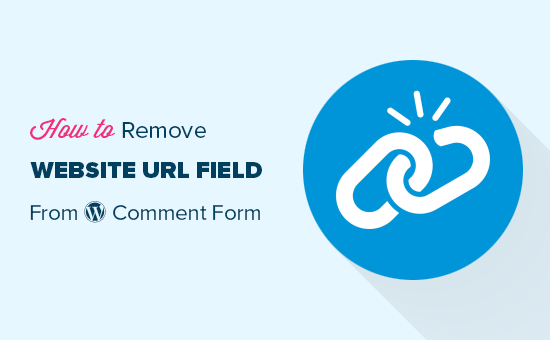
Dlaczego ludzie wysyłają spamerskie komentarze?
Ponieważ większość spamu jest generowana przez zautomatyzowane boty, można łatwo zwalczać spam w komentarzach za pomocą bezpłatnych narzędzi i wtyczek. Znacznie trudniej jest jednak powstrzymać spam w komentarzach przesyłanych przez ludzi.
Komentarze te są często nie na temat, nieistotne i nie wnoszą żadnej wartości do rozmowy.
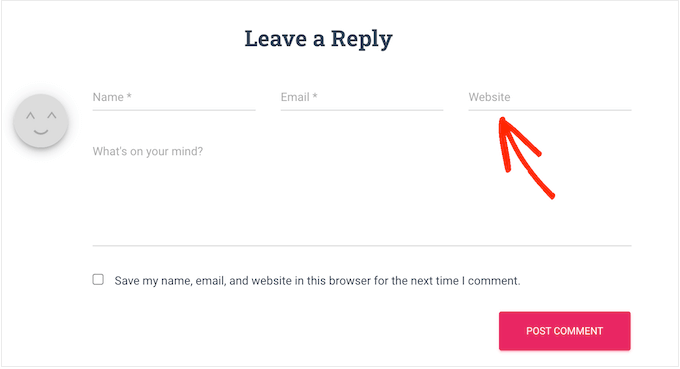
Wyświetlając komentarze, WordPress automatycznie odnośnik do nazwy użytkownika danej osoby z podanym przez nią adresem URL witryny internetowej. Spamerzy mogą wykorzystywać to pole, aby uzyskać linki zwrotne lub spróbować uzyskać lepsze rankingi dla określonych słów kluczowych.
Usuwając pole adresu URL witryny, możesz zniechęcić spamerów do wpisów na twoim blogu lub witrynie internetowej WordPress. I jak widać w naszym formularzu komentarza WPBeginner, wyłączyliśmy dokładnie tę funkcję w ten sposób:

Robimy to, ponieważ wierzymy, że prawdziwi użytkownicy zostawią komentarz bez względu na to, czy otrzymają link zwrotny, czy nie. Nie powinno to więc wpływać na liczbę wysokiej jakości komentarzy.
Biorąc to pod uwagę, przyjrzyjmy się 3 różnym metodom usuwania pola witryny internetowej z formularza komentarza na twojej witrynie WordPress. Możesz skorzystać z poniższych odnośników, aby przejść bezpośrednio do wybranej metody:
Metoda 1: Usuwanie pola adresu URL witryny internetowej za pomocą Thrive Comments (zalecane)
Pierwsza metoda wykorzystuje Thrive Comments, najlepszą wtyczkę do komentowania dla WordPress.
Oprócz uniemożliwienia użytkownikom wstawienia spamerskich adresów URL, wtyczkę można również wykorzystać do zwiększenia zaangażowania w komentarze. Przykładowo, możesz zezwolić użytkownikom na polubienie lub nie komentarzy, a nawet przekierować komentujących do odpowiedniego wpisu, aby zwiększyć liczbę twoich odsłon.
Aby uzyskać więcej informacji, sprawdź naszą pełną recenzję Thrive Themes, gdzie mówimy więcej o Thrive Comments.
Najpierw przejdź do witryny internetowej Thrive Themes, aby utworzyć nowe konto i uzyskać płatny plan.

Po rejestracji wystarczy przejść do kokpitu konta.
Kliknij odnośnik “Pobierz i zainstaluj wtyczkę Thrive Product Manager”.
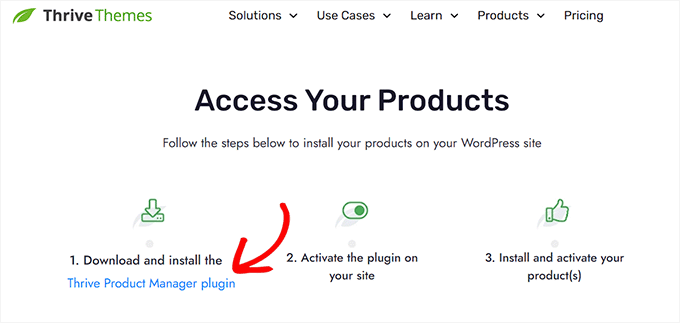
Na tym etapie możesz zainstalować wtyczkę Thrive Product Manager na twojej witrynie WordPress. Więcej szczegółów można znaleźć w naszym przewodniku na temat instalacji wtyczki WordPress.
Teraz przejdź do strony Product Manager z twojego obszaru administracyjnego WordPress i kliknij przycisk “Zaloguj się na moje konto”.
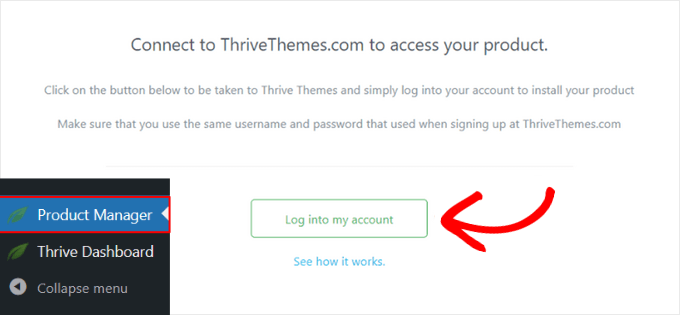
Powinieneś teraz zobaczyć kokpit Thrive Product Manager.
Tutaj wystarczy wybrać Thrive Comments i kliknąć przycisk “Zainstaluj wybrane produkty”.
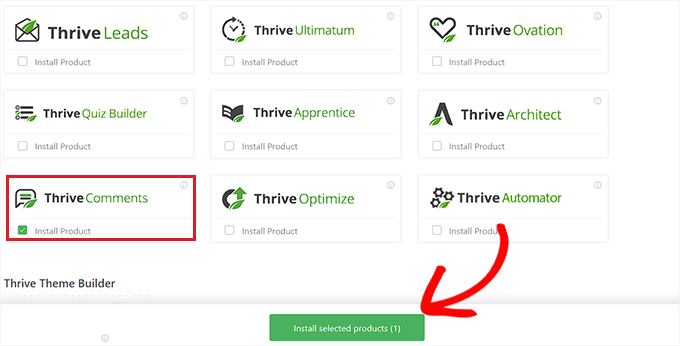
Po zakończeniu instalacji powinien pojawić się komunikat “Gotowe do użycia”.
Teraz wystarczy kliknąć przycisk “Przejdź do kokpitu Thrive Themes” na dole.
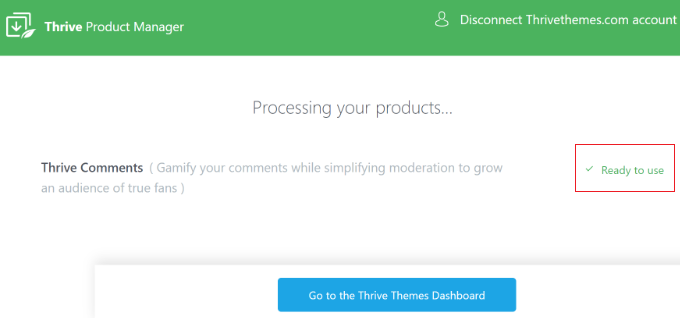
Na następnej stronie zobaczysz wszystkie twoje zainstalowane wtyczki w pakiecie.
Kliknij przycisk “Thrive Comments”, aby rozpocząć korzystanie z wtyczki.
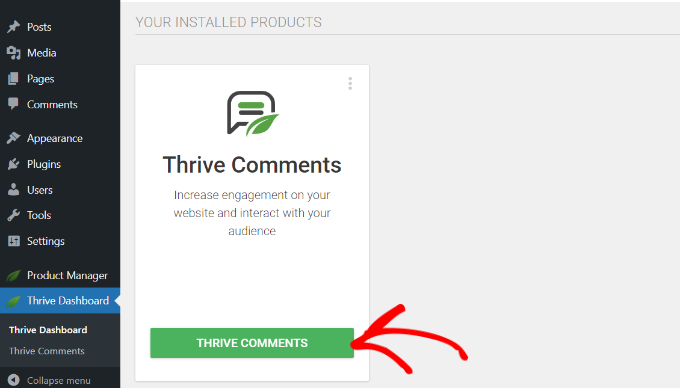
Na stronie Thrive Comments otwórz menu “Comment Sign-In”.
Następnie wyłącz ustawienie “Zezwalaj gościom na wstawienie adresów URL witryn internetowych”.
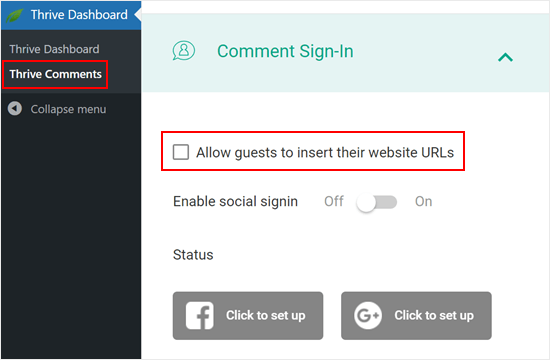
Ta opcja usuwa pole adresu URL witryny z twojej witryny internetowej WordPress.
W ten sposób twoja sekcja komentarzy pozostanie wolna od spamu, a prawdziwi komentatorzy nie będą przypadkowo klikać złośliwych odnośników.
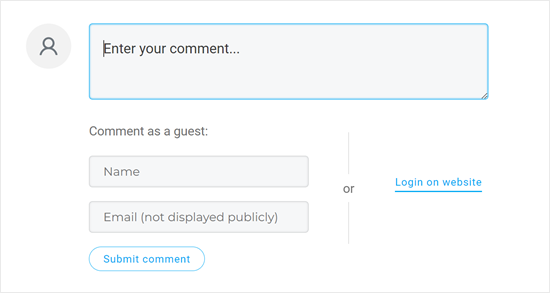
To wszystko. Jeśli jesteś zainteresowany wykorzystaniem Thrive Comments do ulepszenia twojej sekcji komentarzy, oto inne przewodniki, które możesz sprawdzić:
- Jak funkcjonować lub ukrywać komentarze w WordPressie
- Jak umożliwić twoim użytkownikom subskrybowanie komentarzy w WordPressie?
- Jak zezwolić użytkownikom bloga na moderację komentarzy w WordPressie?
Metoda 2: Usuwanie pola adresu URL witryny internetowej za pomocą darmowej wtyczki
Jeśli chcesz usuwać adres URL z twojego formularza komentarza WordPress za pomocą darmowej wtyczki, sprawdź Comment Link Remove i Comment Tools.
Ta wtyczka pozwala usuwać pole, a także usunąć wszelkie odnośniki z komentarzy, które zostały już zatwierdzone.
Najpierw należy zainstalować i włączyć wtyczkę Comment Link Remove i Comment Tools. Szczegółowe instrukcje można znaleźć w naszym przewodniku na temat instalacji wtyczki WordPress.
Po włączaniu kliknij Narzędzia komentarzy “ Narzędzia komentarzy w kokpicie WordPress.
Tutaj zaznacz pole obok “Usuwaj pole witryny internetowej z formularza komentarza”. Zniechęci to spamerów do wstawienia swoich odnośników.
Jednak wszystkie wcześniej zatwierdzone komentarze nadal będą zawierać odnośnik. Aby usunąć te adresy URL, wystarczy zaznaczyć pole obok opcji “Usuń hiperłącze z komentarza AUTHOR Bio”.
Zalecamy również zaznaczenie ustawienia “Wyłącz przekształcanie adresów URL w hiperłącza w komentarzach”. Opcja ta zapobiega wyświetlaniu adresów URL w komentarzach jako klikalnych hiperłączy.
Poza tym można opcjonalnie włączyć opcję “Usuwaj odnośniki HTML w komentarzach”. To ustawienie usuwa tagi HTML, które tworzą hiperłącza w komentarzach. Dzięki temu wszelkie adresy URL lub odnośniki w komentarzach nie będą wyświetlane jako klikalne.
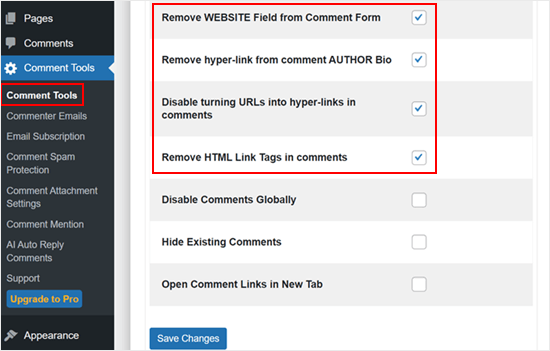
Po zakończeniu przewiń do dołu strony i kliknij przycisk “Zapisz zmiany”, aby zapisać twoje ustawienia.
Aby zobaczyć tę zmianę w działaniu, wyloguj się ze swojego konta lub przejdź na swoją witrynę internetową w karcie incognito.
Zobaczysz, że formularz komentarza nie ma już pola adresu URL witryny internetowej.
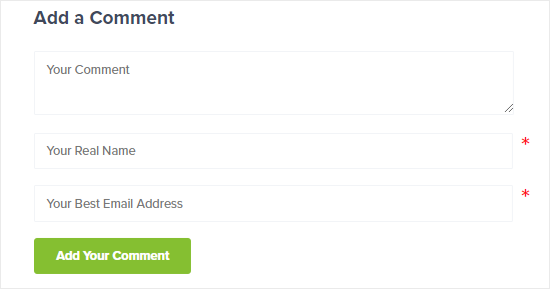
Ponadto nazwy autorów komentarzy, które wcześniej zawierały odnośniki, nie będą już ich zawierać, a użytkownicy nie będą już mogli w nie kliknąć.
Jednym ze znaków ostrzegawczych jest to, że kolor tekstu nazwy autora komentarza, który zawierał odnośniki, będzie taki sam jak ten, który ich nie zawiera.

Metoda 3: Usuwanie pola adresu URL witryny internetowej za pomocą kodu
Inną opcją jest usuwanie pola witryny internetowej z formularza komentarza WordPress za pomocą fragmentu kodu.
Powodem, dla którego chcemy pokazać tę metodę, jest to, że chociaż wtyczka może usuwać pole adresu URL, nadal zachowuje pole wyboru “Zapisz moje imię i nazwisko, e-mail i witrynę internetową w tej przeglądarce do następnego komentowania” u dołu.
Aby zachować spójność, chcemy zmienić ten tekst na “Zapisz moje imię i e-mail w tej przeglądarce do następnego komentowania”. Możemy to zrobić za pomocą własnego kodu.
Często poradniki mówią, aby dodać własne fragmenty kodu do pliku functions.php twojego motywu.
Jednak nie zalecamy tego, ponieważ nawet mały błąd w twoim kodzie może spowodować wiele typowych błędów WordPressa lub nawet całkowicie zepsuć twoją witrynę. To podejście wymaga również utworzenia motywu potomnego, aby twój motyw nadrzędny nie miał wpływu.
Zamiast robić to wszystko, zalecamy użycie WPCode. Jest to najłatwiejszy i najbezpieczniejszy sposób dodawania własnego kodu w WordPressie bez konieczności edytowania jakichkolwiek plików rdzeni motywu.
Uwaga: Chociaż istnieje darmowa wtyczka WPCode, w tym poradniku użyjemy wersji premium.
Pierwszą rzeczą, którą musisz zrobić, to zainstalować i włączyć wtyczkę WPCode na twojej witrynie internetowej. Aby uzyskać więcej informacji, zobacz nasz przewodnik krok po kroku, jak zainstalować wtyczkę WordPress.
Dodawanie kodu usuwającego pole adresu URL z formularza komentarza WordPress
Po włączaniu, przejdź do Code Snippets “ Add Snippet.
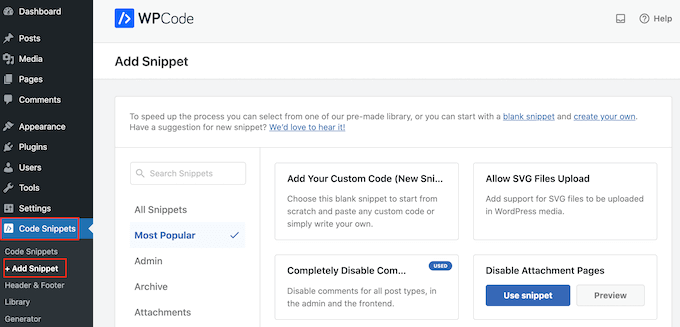
Następnie przejdź do karty “Komentarze” i znajdź fragment kodu “Disable Comment Form Website URL”.
Jeśli jeszcze nie połączyłeś się z biblioteką WPCode, to teraz kliknij przycisk “Połącz z biblioteką, aby odblokować (Free)”.
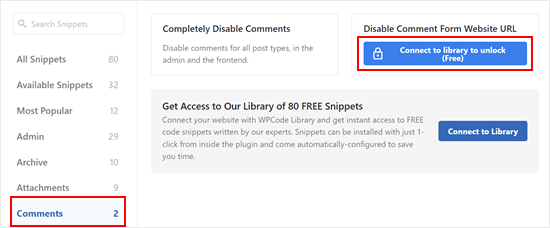
Na tym etapie wystarczy logować się na twoje konto WPCode.
Następnie wystarczy powrócić do poprzedniej strony wtyczki WPCode. Zobaczysz teraz, że przycisk zmienił się na “Użyj fragmentu kodu”. Kliknij go, aby go użyć.
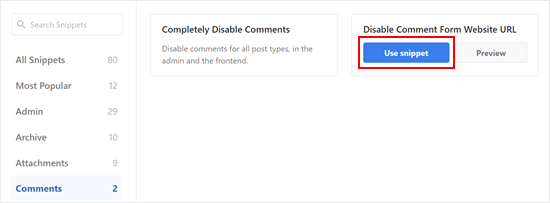
Zobaczysz teraz ekran edytora fragmentów kodu z kodem usuwającym pole adresu URL witryny z formularza komentarza.
Wszystko, co musisz teraz zrobić, to kliknąć przełącznik “Nieaktywny”, aby zamiast tego wyświetlił się “Aktywny”. Następnie kliknij “Aktualizuj”, aby fragment kodu stał się aktywny.
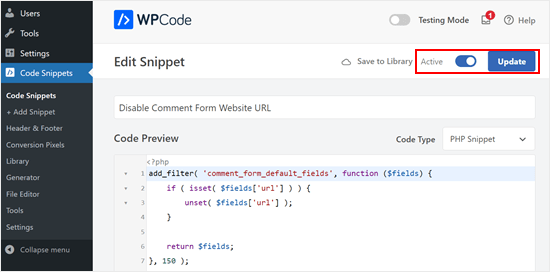
Teraz odwiedzający nie mogą już dodawać adresu URL witryny internetowej do swoich komentarzy.
Dodanie kodu usuwającego istniejące odnośniki w nazwach autorów komentarzy
Kod z poprzedniego kroku usuwa jedynie pole adresu URL witryny internetowej z formularzy komentarzy, ale istniejące komentarze z odnośnikami do nazwisk autorów nadal będą zawierać odnośniki.
Na szczęście można je również łatwo usuwać za pomocą WPCode. Wystarczy wrócić do sekcji Fragmenty kodu “ Dodaj fragment kodu. Następnie kliknij “Użyj fragmentu” w sekcji “Dodaj własny konfigurator (nowy fragment kodu)”.
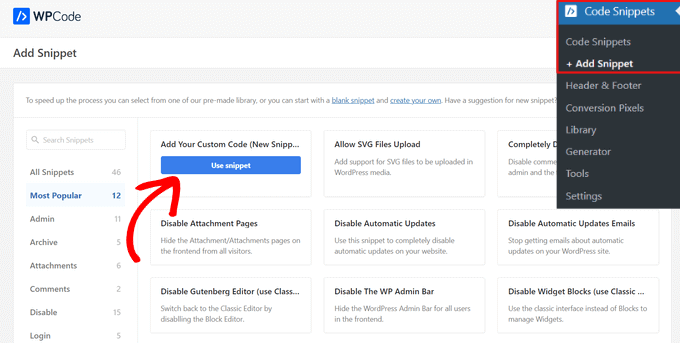
Teraz możesz nadać temu fragmentowi kodu nazwę, aby ułatwić jego identyfikację. Może to być coś prostego, jak “Usuwanie hiperłączy w nazwie autora komentarza”.
Następnie zmień fragment kodu na “PHP Snippet”.
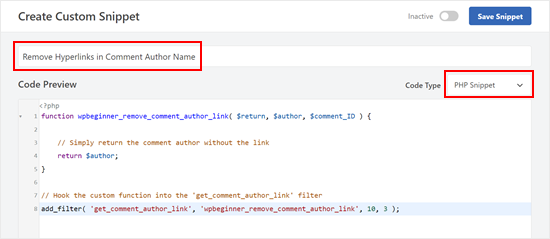
Po zakończeniu skopiuj i wklej poniższy fragment kodu w polu podglądu kodu:
1 2 3 4 5 6 7 8 | function wpbeginner_remove_comment_author_link( $return, $author, $comment_ID ) { // Simply return the comment author without the link return $author;}// Hook the custom function into the 'get_comment_author_link' filteradd_filter( 'get_comment_author_link', 'wpbeginner_remove_comment_author_link', 10, 3 ); |
Przewijając w dół, upewnij się, że Metoda wstawiania to “Automatyczne wstawianie”, a Lokalizacja to “Uruchom wszędzie”.
Następnie wystarczy włączyć kod i kliknąć “Zapisz fragment kodu”.
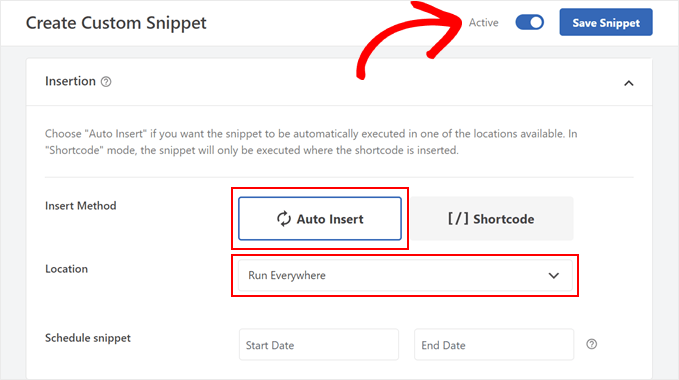
Teraz starsze nazwy autorów komentarzy nie będą już zawierały odnośników.
Dodanie kodu zastępującego tekstpola wyboru Comments Cookies Opt-In
Jeśli zdecydujesz się wyświetlić pole wyboru dotyczące plików ciasteczek w Twoim formularzu komentarza, najprawdopodobniej zobaczysz ten tekst pola wyboru: “Zapisz moje imię i nazwisko, e-mail i witrynę internetową w tej przeglądarce do następnego komentowania”.
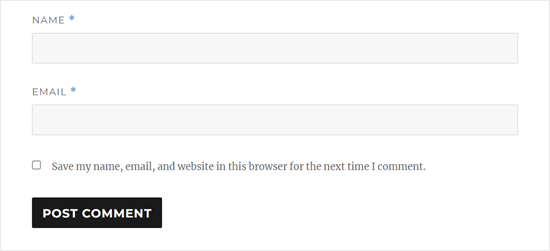
Posiadanie tego pola wyboru w taki sposób, gdy nie ma już pola adresu URL witryny internetowej, będzie wydawać się dość niezręczne. Dobrym pomysłem jest więc zastąpienie tego tekstu.
Aby to zrobić, wystarczy utworzyć nowy fragment kodu, tak jak w poprzednim kroku, i ustawić rodzaj kodu “Fragment PHP”. Możesz nazwać ten kod “Replace Comments Cookies Opt-In Checkbox Text”.
Następnie skopiuj i wklej poniższy fragment kodu w polu podglądu kodu:
1 2 3 4 5 6 7 8 9 10 11 12 13 14 | // Hook a custom function 'remove_website_from_checkbox_text' into the 'gettext' filteradd_filter('gettext', 'remove_website_from_checkbox_text');function remove_website_from_checkbox_text($translated_text) { // Replace the original text with the modified text $translated_text = str_replace( 'Save my name, email, and website', // Original text to find 'Save my name and email', // Replacement text $translated_text // The text being processed ); // Return the modified translated text return $translated_text;} |
Ustawienia Metody wstawienia i Lokalizacji mogą być takie same jak poprzednio.
Gdy to zrobisz, po prostu włącz kod i kliknij “Zapisz fragment kodu”.
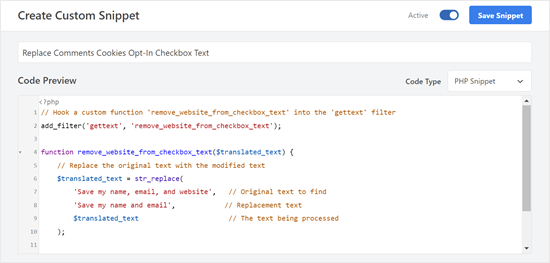
Jeśli kod się powiedzie, tekst opt-in powinien zostać zmieniony na “Zapisz moje imię i e-mail w tej przeglądarce do następnego komentowania”.
Oto jak wygląda tekst opt-in na naszej witrynie testowej:
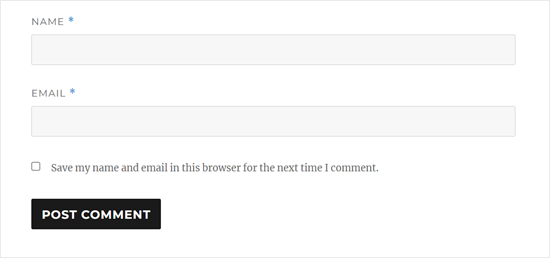
Mamy nadzieję, że ten artykuł pomógł ci dowiedzieć się, jak usuwać pole adresu URL witryny internetowej z formularza komentarza WordPress. Zachęcamy również do zapoznania się z naszym przewodnikiem dla początkujących na temat moderowania komentarzy w WordPressie oraz wyborem najlepszych wtyczek do formularzy kontaktowych.
If you liked this article, then please subscribe to our YouTube Channel for WordPress video tutorials. You can also find us on Twitter and Facebook.





Leslie
I don’t know, do it with the instruction, and some websites don’t work.
WPBeginner Support
If it does not work on a site, it likely means that the theme being used is overriding the default comment form.
Admin
Dipu
Hello, thank you for creating a valuable blog post as it was a question of many about how to remove the website field from the comment form.
I want to know that if allowed the website filed, is it helpful for SEO, because they are nofollow links?
WPBeginner Support
It should not be a major factor in your site’s SEO with either choice.
Admin
Tal
Thanks the php code works great!
WPBeginner Support
Glad it was able to help you!
Admin
osama
well done, and thank you for your great work
WPBeginner Support
You’re welcome, glad you found our guide helpful!
Admin
Giri
Thank You.
I have updated, and the field has been removed.
WPBeginner Support
Glad our guide was able to help!
Admin
Anna Mildwater
Hi, this didn’t work for me (adding the code in the functions.php file) to remove the url field. I’m using a child theme for Astra, so i added it to the functions.php for that. Is that correct?
WPBeginner Support
Adding it to your child theme’s functions.php is the correct thing to do. If it didn’t remove it for you, the theme you are using may have its own method for displaying the field where you would want to check with the support for the child theme you are using and they should be able to assist!
Admin
Andres Berejnoi
Thank you for this tutorial. I have been looking for a way to remove that field for a while. It makes the comment section look more crowde, and it is just an extra step for a legitimate commenter. However, is it possible that my site will become slower if I install these kinds of plugins to solve each problem?
So far, I have not noticed the difference, but I have installed only maybe 5 besides the ones that come by default with the theme.
WPBeginner Support
It would depend on the plugin for how it would affect your site’s speed, for our opinion on plugins and how they affect your site you would want to take a look at our article below:
https://wpbeginner.com/opinion/how-many-wordpress-plugins-should-you-install-on-your-site/
Admin
Obaid
What I do is manually approve comments. Might be exhaustive for a large website, but it’s useful for beginners.
WPBeginner Support
Thanks for sharing what works for you
Admin
Arthur Morehead
The plugins have not been updated in 5 years so I’ll just use the code to remove the URL field. I am using Generate Press (child) theme and not sure if I place it before or after the ?>
Laurens
Excellent! I updated the functions file and that now hopefully gets rid of all the spammy comments on my site.
WPBeginner Support
Hopefully, it at least reduces the amount of spam
Admin
Dan
This still works in 2021.
Thanks for the code. That was easy! Glad to be rid of the website URL field for the comments.
WPBeginner Support
Glad our guide was helpful
Admin
Emmeline
Is there any way to block specific URLs from the actual comment content? When I removed the website field and hyperlink ability, it didn’t stop the spammers from just typing their website at the bottom of their comment. The default “disallowed comment keys” feature matches inside words and not just the entire URL, so I can’t block them that way either (they aren’t using distinct keywords). And of course they use a different email address every time, even though I can tell it’s the same person/group. Right now I’m deleting their comments manually, but it’s very annoying because there are so many. Any advice?
WPBeginner Support
For preventing comment spam, you would want to take a look at the recommendations in our guide below:
https://www.wpbeginner.com/beginners-guide/vital-tips-and-tools-to-combat-comment-spam-in-wordpress/
Admin
Seth
Very helpful. Couldn’t leave without saying thank you
WPBeginner Support
Glad our guide was helpful
Admin
Huzaifa Farrukh
First of all, thanks for always sharing useful tutorials like this.❤️
Secondly, I think I probably never had spend my more time on comment section instead of the article itself…
Quite a conversation going on between Syed and “commenters”
WPBeginner Support
Glad you like our tutorials and there likely is some spam that got by in the comment section if that is what you are talking about. Not everyone is perfect in terms of moderating comments.
Admin
Sharon
Thank you for this post among your other informative posts. This was very helpful. I have been receiving spam comments with website links to other websites. It didn’t help that WordPress has default “website” field for those leaving a comment. This helps. Thanks again for writing this article.
WPBeginner Support
You’re welcome, glad our guide was helpful
Admin
José Vicente Santos Aguilar
Finally I founded code that works. Thanks
WPBeginner Support
You’re welcome
Admin
mohit nagar
hello sir,
i use your tutorial to remove website option from comment.
i copy and paste the code in my functions.php but it only website field location change.
WPBeginner Support
You may want to check with your specific theme’s support to see if they could be overriding something on their end.
Admin
Sameer
Thank you Sir it’s very helpful plugin & information As well as
WPBeginner Support
You’re welcome
Admin
malika
Very informative,i liked…….
WPBeginner Support
Glad you liked our article
Admin
James Emmanuel
Thanks for this article, it was helpful… too much spams while comment section of our site was with link. we actually switched to disqus, but disqus java was too much and had some impart on site speed. with your gauide, we are again back to normal.
WPBeginner Support
Glad our guide was helpful
Admin
md somon
Very helpful post, thank you so mutch
WPBeginner Support
You’re welcome, glad our post was helpful
Admin
Rui Nogueira
Yes but is there any way to automatically erase comments that have links ? ( either bots or human typed )
WPBeginner Support
We do not have a recommended method at the moment sadly.
Admin
Dana
Thank you very much!
WPBeginner Support
You’re welcome
Admin
Will Wilson
Is it okay to delete the plugin afterward, or will the website option pop up again in the comment form?
WPBeginner Support
You would need to keep the plugin for it to keep hiding the fields
Admin
Olidur Rahman
Really very helpful thank you!
WPBeginner Support
You’re welcome, glad you found our guide helpful
Admin
hadil
thank you very nice website article
WPBeginner Support
You’re welcome, glad you like our content
Admin
pawan
Your articles always helpful for me,
All content on the website really very helpful
Thanks a lot for sharing such a helpful information
WPBeginner Support
Glad our article was helpful
Admin
Vara Prasad
Hey big fan for wpbeginner website and your code works perfectly for my disktop& mobile website can plz tell my how to remove Website URL Field from Amp pages and post please
WPBeginner Support
This code should work for the url field for comments on those pages as well
Admin
VARA PRASAD
i used code from wpbeginner website which works perfectly for the normal site but Amp pages showing Website URL field i am using newspaper theme
WPBeginner Support
You may want to reach out to your theme’s support to see if they have styling set up that could be overriding the code here
arun mishra
Great articles. i love reading this. Thnx
WPBeginner Support
Glad you enjoy our articles
Admin
JTCAD
Very detailed article. there is more in comments rather than article even.
WPBeginner Support
Glad you found our article helpful
Admin
Miracle Darlington
Well detailed article.. Learnt alot more from comments than the article itself tho.
George Conklin
I came to your website on purpose looking for a way to remove the Website/URL field on comments forms when I cannot use the functions.php method, so obviously I was looking for a plugin to do that. There doesn’t seem to be an up-to-date and reliable plugin that does this unless its baked into the functionality of another plugin. It might be a great idea to update this post just for that purpose – a working plugin
Iqbal Hussain
How to edit “Your email address will not be published. Required fields are marked *” in wordpress comment form?
Tia Mcintosh
Hey i downloaded and activated both and neither did anything to the comments box. I am just trying to get ride of the option for the comment author to put their website in.
Vishal
Hey there everyone, my theme is Twenty-Seventeen and I was able to remove the “Website URL” field from the Comment Section by just adding this single line code to “Additional CSS” section while customizing it through Appearance>Customize. The code is:
.comment-form-url {display:none;}
This might help or give you some idea I hope
WPBeginner Support
Hi Vishal,
It does not remove the comment form url field, it just hides it. Spamming bots will still be able to see and fill it.
Admin
obed
uncheck the ‘required email and website’ options in settings -> discussion on the dashboard
add the following code to your custom css
#respond .comment-form-email, #respond .comment-form-url {
display: none;
}
bill
Thank you, this has worked a bit…
Naeem Hussain
Dear is there any other way to disable website field from my ComputerPakistan Website. Actually I do not want to add any more plugin in my site.
Pravin Singh
Great article and good information. However, both the plugins mentioned have not been updated for many years and could have compatibility issues with latest versions of WordPress.
Is there an alternative plugin to disable these URLs? If yes, could you kindly update the article as it would be really useful
WPBeginner Support
If you are comfortable adding code to WordPress, then you can try this code in a site-specific plugin or your theme’s functions.php file:
functionwpb_disable_comment_url($fields){unset($fields['url']);return$fields;}add_filter('comment_form_default_fields','wpb_disable_comment_url');1-click Use in WordPress
Admin
IMRAN KHAN
I have added this code in my themes functions.php and it worked but please can you tell me how to rearrange comments section options.My website shows comments option before name and email but i want to show name and email first and then comment option.
Jazib
Hi guys
I like the article but i have concern here that plugins that you have recommended are two years old and unmaintained. Should i install it or not?
Currently i am using No Captcha service from Google via a plugin.
yellowans
hello guys
very interesting topic helped me a lot. here is my issue I deactivacted name, email and url, from my comments. now my comment section is just that comments, nothing else shows.
however the comment for still shows a space for name email and url, the url box I canceled and is not displaying anymore thanks to a plugin,
my question, which plugin (not really a fan of css) can I use to rid of name and mail on the comment entry form thank you and regards
website theme twenty thriteen
Farhan Shah
I had used a plugin “stop spam comments” for stopping spam comments. but after few week felt that I have reduced website hit on my website. my question is that comments has been stopped but why reduced website hits?
Please tell me should I remove this “Stop Spam Comments” plugin and install this plugin “Disable / Hide Comment URL”?
regards
Ciprian C.
Why not just CSS?
p.comment-form-url {height: 0 !important;overflow: hidden !important;}
not the best solution but it works for me.
WPBeginner Support
It will only make the URL field invisible, spam bots will still be able to use the URL field so it doesn’t serve the purpose.
Admin
Chris Mayell
I can corroborate that CSS changes will not suffice.
I was hoping that a simple display:none trick might work. But the messages keep coming.
I’m going to install the plugin you mentioned now.
Thanks to the author for the good suggestion & helpful article.
hassan Gul
thanx.it’s realy help me out.
Colin Crawford
Perhaps the major search engines should look into this as well. These backlinks are getting out of hand, just like when we added keywords to the meta keywords tag. That was abused and now these backlinks are getting abused.
I use a plugin called Disable Comments throughout some of my websites so no one can leave any. So far it has worked but the other websites receive on a daily basis quite a number. Reading through them, there is many adverts with lots of links, people saying how insightful your website is. For one I do not or have ever heard anyone say insightful so straight into the Spam bin.
I don’t think the amount of backlinks should influence your rankings as they can be too easy to get. I went after a web design job and the owner wanted to do some Off page SEO and wanted the successful applicant to be able to get at least 2000 backlinks for that website. Well I didn’t get the job and glad, probably spend the day leaving insightful comments on other peoples websites.
Editorial Staff
Hey Colin,
Comments definitely encourage conversations like this one here. But yes, spammers are ruining it for the webmasters. Getting rid of the link feature has definitely helped reduce spam comments on the site.
Admin
Damien
Any way to remove the comment url from comments when using Jetpack?
Editorial Staff
If the above plugin doesn’t work, then you would have to dissect the Jetpack code (that’s the only other alternative).
Admin
Jenny
Wondering if you could address a couple of concerns? For the plug-in “Disable / Hide Comment URL”
1. is only compatible to 3.2.1.
2. the last update was 2011-9-2 (really old)
Editorial Staff
If you look at the code of this plugin, it is very simple, and it works. You can take the code and dump it in your functions.php file…
functiondisable_comment_url($fields) {unset($fields['url']);return$fields;}add_filter('comment_form_default_fields','disable_comment_url');1-click Use in WordPress
So in short, no this plugin is compatible with recent versions. The author just didn’t update the plugin because it simply works. Why update when it is not broken?
Admin
Regev
Awesome!
How do I also…
1. Change the default “Your email address will not be published. Required fields are marked *” into a custom text, like you have done.
2. Remove the * from “Name” and “Email”, and change “Name” to “Your Real Name”
Thanks.
Gautam Doddamani
i guess we already had a long conversation about this a long time back…i think since you got rid of livefyre…yea i agree this helps get rid of spam users and keep legit comments comin’! real nice plugins…wil check ’em out!
Cheers,
Gautam
Shalu Sharma
Nice article and I can understand why people want to remove it but can’t you use the right plugins to moderate and control spam? Thanks for the tutorial, if I do decide to then I know where to look for it.
Cliff Beneventi
Thanks for the article. Reducing or eliminating spam is a critical part of comment management. Akismet does a great job for my clients, but uses URL’s to determine if a comment is spam. This plugin would then render Akismet less effectual. Also, the user can simply insert a URL in the comment itself, can they not? Lastly, I thought that the bulk of spam comments were generated by bots, which would still populate the comment field, even in the absence of a URL field.
Zimbrul
What crosses my mind right now is this “being WPBeginner, o e of the solid sites out there providing quality WordPress tutorials and advice, you can afford to not show the author link on your comment form”. In fact this will dicourage many to comment unless they really have something to say.
I only comment on articles that interest me and never said just “oh, great article, I’ll bookmark it, fantastic piece of writing”.
Elliott Richmond
Agreed, if someone is making the effort to comment on an article the least you can do is credit them with a link! After all it’s about the community right? I noticed this on WPB a while ago and it put me right off commenting full stop! Not that I comment for the backlink because it’s a nofollow anyway but because if any other commenters what to check me out they can.
Zimbrul
Yes, this is the idea of the author website field. But, as I said, I do mot comment here at wpbeginner for backlinks or for make myself known. I use WP Beginner website to get answers and to implement new te tehniques on sites I develop.
I only comment to topics I can “technically” comment, that’s it.
Editorial Staff
Elliot, first of all I’m sorry to hear that you have stopped commenting on WPBeginner just because we decided to get rid of the URL field. While your initial intentions weren’t to get backlinks, but your decision to stop commenting after we get rid of the field only emphasize the point.
If you do not think that a community is worth contributing to just because you are not getting a backlink/promotional value, then I don’t think that you value the community enough.
We have had internal communications about establishing a proper registration system for regular users on WPBeginner. This would allow us to unlock certain perks (i.e backlinks to all of your new and previous comments after you hit comment count marker X). But again, I feel odd because I’m offering incentives for users to comment which is favoring quantity over quality.
I will probably have this added as one of the questions in our annual survey for the WPBeginner audience.
Admin
Elliott Richmond
Not “stop commenting” or “stopped commenting” just “put off” ^_^
On the contrary I do value the community and I hope that I do offer value back to the community (albiet in a very small way compared to others) and I find your tone a little insulting to be honest!
I believe that there are other contributors who I would certainly like to find out more about but seeing as you have denied a link back to their site where I can find out about “the community” it kind of defeats the object wouldn’t you agree? Fortunately I do recognised some of the contributors who I do value, Pippin being one of them but, if I’d like to find out about others then I have no chance right?
Editorial Staff
I won’t argue semantics of stop commenting or “commenting full stop”. Nonetheless, I see your point of finding user’s information and following up with them elsewhere. One thing that can be done perhaps is hyperlink all gravatar images with the user’s gravatar profile? Would you say that is a good solution?
Always love hearing user feedback. This is why I will be adding this in the user survey that we are planning on sending out.
-Syed
Editorial Staff
Zimbrul, first of all, I really appreciate you as a user. I have your gravatar memorized because I know you are one of our regular users. This technique is not to discourage users like yourself because you add relevant and useful conversation to the articles like this comment of yours.
It is also one of the reasons why our site automatically approves your comment But you are among the exception. I can personally tell you that this is a big issue specially if you are running a tech related tutorial blog.
But you are among the exception. I can personally tell you that this is a big issue specially if you are running a tech related tutorial blog.
SmashingMagazine has the same thing. They did this long time ago, way before WPBeginner. Reason was the same. I as a user appreciated their decision of getting rid of URLs because then I could engage in meaningful conversations with real people (not those drop by’s who might add controversial comment just to get a backlink and never check back).
-Syed
Admin
Zimbrul
Syed, your kind words means more than a backlink for me, don’t you guys agree? For me the words of appreciation from one of the most respected figures in WordPress community means a lot and as I said I come here not for the backlink but for problem solving most of the time. Sometimes I need advice sometimes I can contribute.